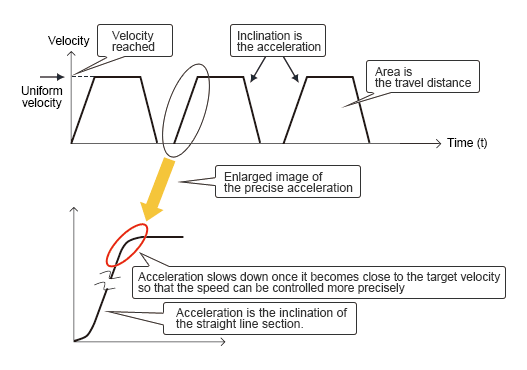#244 Mechanical Engineering and Automation Device Design - 10: Fundamentals of Motion
In this volume, we will learn about basic knowledge of motion in order to understand the motion state of a movable body.
(1) Fundamentals of motion
- "Motion" means that an object changes its position with respect to time.
- "Displacement" refers to positional changes of an object. (Since it quantifies the distance and direction, composition and resolution are also possible.)
- "Velocity" refers to the degree of displacement with respect to time. (Since it quantifies the distance and direction, composition and resolution are also possible.) Unit = m/s
- "Uniform motion" means that an object travels at a constant velocity. It can be expressed as V (velocity) = S (travel distance) / t (time).
- "Acceleration" refers to a rate of velocity change with respect to time. A (acceleration) = {V - V0 (initial velocity)} / t
Unit = m/s2
- "Uniformly accelerated motion" refers to motion with constant acceleration.
The velocity after t seconds will be V = V0 + A・t
The travel distance after t seconds will be S = V0・t + (1/2) A・t2
Velocity and travel distance are used for estimating work tact (time) or life hours relative to the sliding distance when designing a linear motion mechanism. They are also utilized for assessing the moment of inertia force.
![[Fig.] Example of a life test for the linear bushing (estimation of velocity, acceleration, sliding distance, and life hours) [Fig.] Example of a life test for the linear bushing (estimation of velocity, acceleration, sliding distance, and life hours)](/tt/en/lca/492_1.jpg)
(2) Motion expressions
The following figure shows a relationship between the time and speed of uniform motion. It is a typical pattern of linear motion (linear reciprocating motion).

- Positioning technology
- Designing and processing
- Sensor Technology
- Automation elements technology
- Clean room technology
- Design hints
- Design tips
- Designing and Machining
- Drive mechanism design
- Hints on designing
- Linear Motion Components
- Locating Technology
- Manufacturing technology
- Motion mechanism design
- Pneumatic Drives
- Production Technology
- Technology Outlook
- General description
- Low-cost automation and materials
- Transfer LCA
- #333 Know-how on automation: Pressurized heating technology - 5: Multilayer pressurized heating process technique
- #332 Know-how on automation: Pressurized heating technology - 4: Points to remember when designing mechanism of pneumatic pressurization method
- #331 Know-how on automation: Pressurized heating technology - 3: Pneumatic pressurization method and pressure profile
- #330 Know-how on automation: Pressurized heating technology - 2: Pressurization method and pressure profile
- #329 Know-how on automation: Pressurized heating technology



